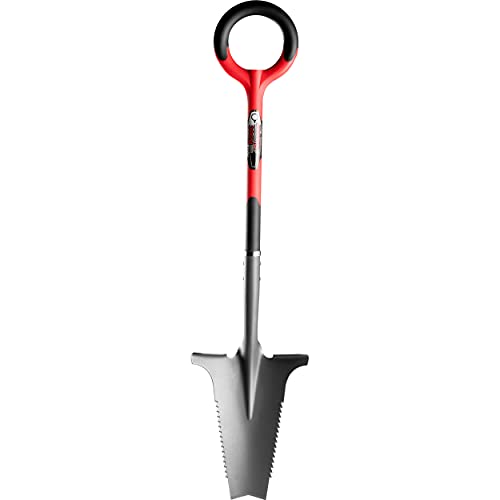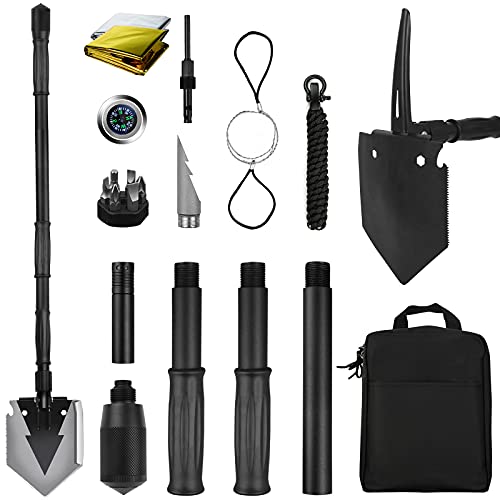
Shovels are essential tools for any gardener or homeowner, but over time they can become rusty and less effective in their job. Rust not only affects the appearance of shovels, but it can also hinder their functionality. However, with the right techniques, you can easily remove rust from shovels and restore them to their former glory.
Before starting the rust removal process, it’s important to gather the necessary supplies. You will need a wire brush or steel wool, sandpaper, white vinegar, a bucket or container large enough to submerge the shovel, and a towel. Additionally, you may want to use a rust converter and primer to provide long-term protection against future rusting.
The first step in removing rust from shovels is to thoroughly clean the tool. Begin by using the wire brush or steel wool to remove any loose rust or dirt. This will make it easier to access the deeper layers of rust. Once you have brushed off the loose rust, use sandpaper to further smooth the surface and remove any remaining rust particles.
Next, prepare a solution of white vinegar and warm water in the bucket or container. The vinegar’s acidic properties help dissolve rust and make it easier to remove. Submerge the shovel in the vinegar solution and let it soak for several hours or overnight. This will allow the vinegar to break down the rust.
Understanding Rust on Shovels
A shovel is an essential tool for many outdoor tasks, but over time, it can develop rust. Rust is a common problem that occurs when iron or steel is exposed to moisture and oxygen for extended periods. Understanding how rust forms on shovels can help you prevent and remove it effectively.
How Rust Forms on Shovels
Rust forms on shovels when the metal comes into contact with moisture and oxygen. When the shovel is exposed to rain, snow, or even high humidity, water molecules react with iron to form iron oxide, more commonly known as rust. This corrosion process is accelerated in the presence of salt or acidic substances.
When you leave a damp shovel in a humid environment or store it without proper drying, you are creating conditions for rust to develop. Even a small scratch or chip in the shovel’s protective coating can provide an entry point for moisture and eventually lead to rust formation.
The Negative Impacts of Rust on Shovels
Rust on shovels can have various negative impacts, including:
|
1. Decreased Efficiency: As rust accumulates on the shovel’s surface, it can hinder its ability to cut through soil, rocks, or other materials efficiently. This can make your yard work more challenging and time-consuming. |
|
2. Weakening of the Shovel: Rust weakens the structural integrity of the shovel, making it more prone to bending, breaking, or even snapping during use. This can lead to safety hazards and render the shovel unusable. |
|
3. Contamination of Soil: When a rusty shovel is used in garden beds or near plants, small rust particles can contaminate the soil. These particles may contain harmful substances that can adversely affect plant health. |
To maintain the effectiveness and longevity of your shovel, it is crucial to address rust issues promptly.
Preparing the Shovel for Rust Removal
Before you can start removing the rust from your shovel, it’s important to properly prepare it. Follow these steps to ensure the best results:
Clean the Shovel
Begin by removing any dirt or debris from the surface of the shovel. Use a stiff brush or a wire brush to scrub away any loose particles. This will help you get a better view of the rusted areas and prevent any further damage during the rust removal process.
Wash the Shovel
Next, thoroughly wash the shovel to remove any remaining dirt, grease, or oil. You can use a mild dish soap mixed with warm water and a scrub brush to gently clean the shovel. Rinse it off with clean water and dry it thoroughly with a towel.
Protect Surrounding Areas
Before applying any rust removal solution, it’s important to protect the surrounding areas. You can use painter’s tape or plastic sheeting to cover any parts of the shovel handle or other areas that you don’t want to get damaged or exposed to the rust removal product.
By properly preparing your shovel, you’ll be able to effectively remove the rust and restore its functionality. It’s an essential step that shouldn’t be skipped before proceeding with the rust removal process.
Methods for Rust Removal
There are several effective methods for removing rust from shovels. Here are some of the most common techniques:
1. Vinegar Solution: Soak the rusty shovel in a solution made of equal parts white vinegar and water. Leave it overnight, then scrub the rust off with a wire brush or steel wool.
2. Lemon Juice and Salt: Squeeze fresh lemon juice onto the rusted areas of the shovel and sprinkle salt over it. Leave it for a few hours, then scrub away the rust with a brush or abrasive pad.
3. Baking Soda Paste: Create a paste by mixing baking soda with water. Apply the paste to the rusted areas and let it sit for a couple of hours. Scrub the rust away with a brush or scouring pad.
4. Coca-Cola: Pour Coca-Cola over the rusty parts of the shovel and let it sit for a few hours or overnight. Scrub away the rust with a brush or scrubbing pad.
5. Sanding: Use sandpaper or a wire brush to remove rust from the shovel. Start with coarse-grit sandpaper and gradually switch to finer-grit paper for a smoother finish.
Remember to wear protective gloves and goggles when using these methods. After removing the rust, rinse the shovel with water and dry it thoroughly to prevent further rusting.
Preventing Rust on Shovels
To keep your shovels in good condition and prevent rust from forming, here are a few tips to follow:
- Clean and Dry: After each use, make sure to clean the shovel thoroughly using water and a brush. Remove any dirt or debris that may have accumulated on the blade or handle. Once clean, dry the shovel completely to prevent moisture from causing rust.
- Apply Protective Coating: Consider applying a protective coating to the shovel to create a barrier against rust. There are various products available, such as rust-resistant paint, clear coatings, or even a simple layer of oil. Apply these coatings according to the manufacturer’s instructions.
- Store Properly: Whenever you are not using the shovel, store it in a dry place. Avoid leaving it in damp or humid areas, as this can accelerate the rusting process. Hang the shovel or store it in a shed or garage where it is protected from moisture.
- Avoid Exposure to Moisture: Try to keep the shovel away from direct contact with water and moisture whenever possible. Avoid leaving it outside in the rain or snow for extended periods. If the shovel does get wet, dry it immediately to prevent rust from forming.
- Maintain the Shovel’s Edge: Regularly inspect the edge of the shovel and sharpen it when necessary. A sharp shovel will be more effective in its tasks and less likely to develop rust. Additionally, a sharp edge allows the shovel to cut through soil and other materials more easily, reducing the risk of surface damage and rust.
By following these preventive measures, you can help extend the lifespan of your shovels and keep them in good working condition for years to come.






